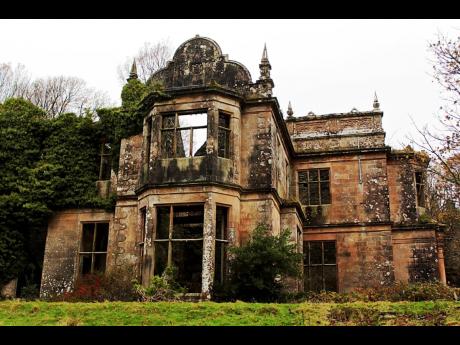Anthony Gambrill | Jamaica in Britain – The Malcolms of Poltalloch
The Malcolms of Poltalloch are typified by historians as feudal inferiors in Argyll, Scotland, who transformed themselves into a wealthy dynasty not only as landlords in their own country, but with enterprises in Jamaica, and, eventually, other West Indian islands, Honduras, and Australia. A minor member of the Campbell clan, they were originally called McCallum.
Alexander Malcolm, the patriarch, married the sister of an Argyll landowner who had a plantation in Jamaica. Alexander’s son, Dugald, was to establish himself as a merchant in Lucea from which he supplied planters both in the island and elsewhere in the Caribbean while maintaining a flourishing trade leasing and selling slaves. He inherited Pell River plantation and became a member of the Jamaican Assembly in 1798.
Those profitable activities allowed him to retire to a residence in Berkshire, England, dying just two years later. He never married, but in his will, he curiously made a provision for his natural son, who was a captain in the British army. Bequests also included sums for “a free mulatto man” and “free mulatto girl” for the two to buy enslaved people. His Hanover properties he left to his cousin Neil Malcolm, laying the foundation for the family fortune.
Neil (1) was a merchant in Glasgow before moving to Jamaica in 1760 then on to London in 1771, which was to be the centre of the Malcolms’ commercial activities henceforth. The family’s success in part thrived on networking based on kinship and family associations typical of the Scots in north-western Jamaica.
In addition, he took advantage of his experience in Glasgow by establishing a trading house that took on the risk of shipping and marketing, at the same time tying planters with advances in credit against storing their commodities for trading from his warehouses. Revenue accrued from sugar, rum, and slaves was eventually overtaken by profits from advances on credit and mortgages. This trading facility was to prove far more amenable to plantation owners who in the past had to bear the shipping and marketing risks themselves.
Malcolm (1) was to use his Jamaican wealth buying land in Britain and investing in shipping. It was during his era that the Malcolms were to become focused on farming in the highlands, which later was to earn them an unfortunate reputation.
In Jamaica, Malcolm (1) acquired several plantations and cattle properties, including Blenheim (the birth place of Sir Alexander Bustamante) and Knockalva Pen, the main residence of the family.
His son, Malcolm (2), succeeded his father on his death in 1802. From his headquarters in the upscale district of Mayfair in London, he accelerated, investing in cattle, timber, and land. The Jamaican plantations, however, continued to be the principal source of income, and his opposition to the abolition of slavery extended to placing a levy on all goods carried by his ships to support a campaign intended to thwart the efforts of William Wilberforce and his colleagues. On the home front, he proved more generous by allowing his highland tenants to illegally distil whisky in order to pay their rents!
As a member of the English parliament, he argued relentlessly against the abolition of slavery and is on record demanding adequate compensation for West Indian proprietors. By this time, the Malcolms were one of the four largest landowners in Jamaica. However, he never visited the island but managed his landholdings through an agent, Daniel Sinclair.
Sinclair, he said, had lived in Jamaica from where he was “in the habit of receiving constant communications”. At Emancipation, he became the beneficiary of his anti-abolition endeavours. For nine estates in Hanover, another in St James, and another in Westmoreland, he was awarded nearly £40,000 (about £5 million in today’s currency). By the time he died, Neil (2) left a fortune equivalent to £53 million.
INVESTMENTS GREW DRAMATICALLY
Their investments in Argyllshire grew dramatically. A census in 1872 of a list of 40 members of the Campbell clan showed them owning 80,000 acres, including the castle of Duntroon. Only the Earl of Breadalbane and the Duke of Argyll had more land.
After 1834, the profits from Jamaica declined at the same time as value of their other investments grew.
It was during the era of Neil (3) Malcolm, born in 1797, that the family’s tenants were evicted in Arichonan Argyll for the land to be converted to sheep farming. Malcolm (3) had decided to enforce an overseer managerial system that had proven very effective for very long in Jamaica. Attempting to dispense with traditional communal ties, this action promoted rioting during which several protesters were arrested. In what must have been seen as an insensitive demonstration of wealth and power, he built a grand Jacobean-styled mansion, Poltalloch House, in the neighbourhood but which today remains roofless and abandoned.
Neil (3) had one son who died at only two and four daughters and was succeeded by his brother, John, remembered only as an art collector.
The Malcolms’ Jamaican centuries-old landholdings finally ended in the 1940s, leaving a legacy of enormous ownership of slaves, and, in their Scottish homeland, of their unsympathetic treatment of their tenants.
The circumstances at Arichonan in 1848 signified a rejection of colonial farming practices and security for small landholders who came under further threat with land-clearance activities leading to widespread migration from the Scottish Highlands in the 1800s.
- Anthony Gambrill is a playwright. Email feedback to columns@gleanerjm.com.

